5 Harmful Myths About Food's Effect On Heart Health
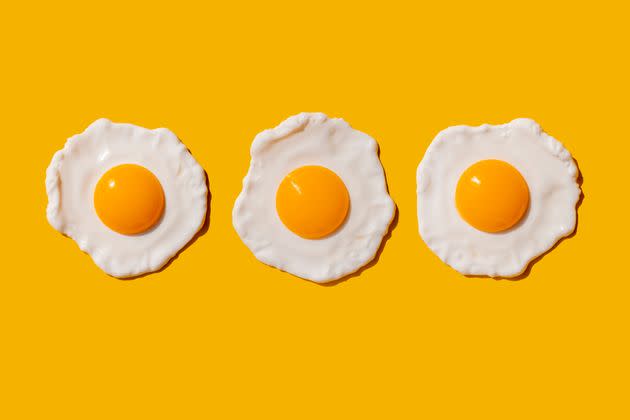
Eggs have gotten a raw deal.
Here’s a sobering fact: Heart disease is the leading cause of death in the U.S., according to the Centers for Disease Control and Prevention. The good news is that it’s largely preventable. The American Heart Association reports that an estimated 80% of cardiovascular disease, including heart disease and stroke, can be avoided when the right diet and lifestyle habits are put into practice.
Empowering, right? The key is knowing the facts and, apparently, there’s a lot the general public gets wrong about heart health — especially when it comes to food. Let’s bust some myths and set the record straight, shall we? Learning the truth may be the one thing you do today that could literally save your life.
Myth 1:A low-fat diet is best for heart health.
Even though we’re not exactly living in the ’90s, when “low fat” was slapped on the packaging of everything from frozen yogurt to cookies (SnackWell’s anyone?), Dr. Steven Masley, a physician, clinical professor at the University of South Florida and author of “The 30-Day Heart Tune-Up,” told HuffPost that many people still believe all fat is bad for heart health. He explained that we should minimize or avoid trans fats (found in many fast foods) and hydrogenated fats (commonly found in over-processed foods), but unsaturated fats are actually beneficial for heart health.
Unsaturated fats are found in foods like fish, olive oil, avocado, nuts and seeds, and scientific studies have found that a diet including unsaturated fats can lower the risk of heart disease.
Myth 2:Eggs are bad for your heart.
Masley, who is also a nutritionist, says many of his patients avoid eggs because they believe eggs raise cholesterol. “But they actually don’t affect cholesterol much at all,” he said.
Two large studies (of roughly 40,000 men and 80,000 women, respectively) found that eating one egg a day was not linked to raising the risk of heart disease. Another scientific study that compared the diet of people in Japan with people in the U.S. found that those in Japan have a lower risk of coronary artery disease despite eating more eggs than people in the U.S.
So how did eggs get a bad rap? Here’s where the confusion likely came from: It’s true that eggs are high in cholesterol. But it turns out that cholesterol in food only has a minimal effect on cholesterol in blood. So what does raise cholesterol? According to Masley (and scientific research), foods high in saturated fat are the big culprit. This includes sausage, bacon and other fatty meats, fried foods, butter and dairy products ― but not eggs.
Myth 3: Red meat should be avoided at all costs.
In moderation, red meat itself may not be as bad for your heart health as the foods you’re eating alongside it. While many studies link the consumption of red meat to an increased risk of heart disease and death, the numbers aren’t as drastic as you might think. A 2020 study from Northwestern University Feinberg School of Medicine and Cornell University, for example, found that eating two 3.5-ounce servings of red meat per week was linked to a 3%-7% higher risk of cardiovascular disease and a 3% higher risk of death.
A scientific reportpublished in 2019, on the other hand, suggested no link between red meat and heart health. The report took three years to compile, taking into account work from 14 researchers in seven different countries. The report’s authors analyzed research that focused on the impact of red meat consumption on heart health and cancer. This included 61 studies that followed a combined total of more than 4 million people, as well as 73 articles. Ultimately, they found the evidence lacking. For every study they analyzed, the researchers found the link between red meat and disease ranged from low to very low.
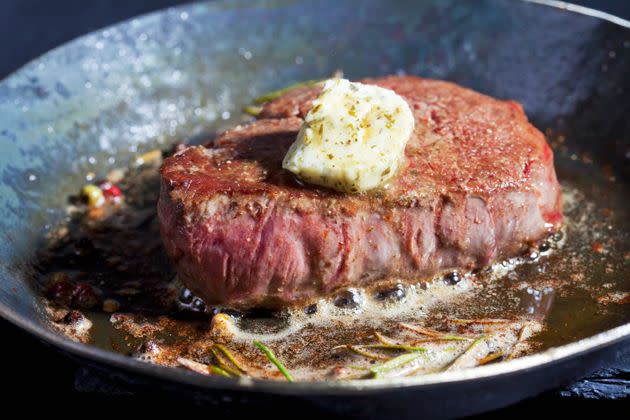
What's potentially worse for your heart than red meat? The butter you put on it, and the fries you eat alongside.
You know what is not-so-great for heart health? According to Dr. Philip Ovadia, a cardiac surgeon and the author of “Stay Off My Operating Table,” the real problem is pairing your red meat with a lot of sauces, fries and soda. It’s these things, he said, that negatively impact heart health, not so much the meat. Sauces and fries can both be high in sodium, which can increase blood pressure. Additionally, fries are high in trans fats, which are linked to an increased risk for heart disease. As for soft drinks, regular soda (which is high in sugar) and diet soda (with artificial sweeteners) are both linked to increases in the risk of heart disease. When you do eat red meat, remember to avoid high-fat cuts. As previously explained, fatty meats are high in saturated fats — something that does negatively impact heart health.
Myth 4: If you’re on medication for heart health, it means you can eat whatever you want.
It would be nice if you could just pop a pill and then do whatever you wanted with no consequence to your body, right? Masley shared that some of his patients on medications, such as statins (cholesterol-lowering drugs), act this way. “I can’t tell you how many patients I’ve had who went out to eat at a restaurant thinking that if they just take another cholesterol pill they can eat whatever you want,” he said. Sorry, folks, no pill can outweigh diet and lifestyle.
Masley explains that eating a diet full of nutrient-poor food and not exercising undermines the statins, causing them not to work as well. Data backs this up. A scientific report taking into account over 69,000 people found that while statins can be beneficial as a primary prevention for heart disease, they are not associated with a lower risk of a heart disease-related death. A major reason for this is because statins do not impact weight, and scientific studies show that a nutrient-poor diet can cause obesity, which is a major risk factor for cardiovascular disease.
Myth 5: At some point, changing your diet isn’t enough to reverse damage already done to your heart.
Ovadia emphasizes that it’s never too late to start looking after your heart. Even if you’ve been diagnosed with heart disease, healthy diet and lifestyle habits can still lower its impact. “I’ve had patients who I’ve performed heart surgery on and they greatly improve their health afterwards when they start paying attention to diet and lifestyle,” he said.
What’s empowering about heart health is that so much of it is in our control. No one is destined to experience a heart attack, regardless of what your family history is or even what your own history is. All you have to do is take these words of wisdom to heart.
Want to kickstart a healthier diet? These are the tools chefs use to keep things on the up and up.
HuffPost may receive a share from purchases made via links on this page. Every item is independently selected by the HuffPost Shopping team. Prices and availability are subject to change.
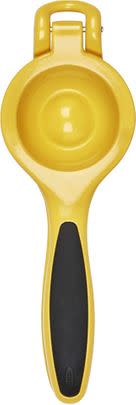
Amazon
OXO Good Grips citrus squeezer
Sometimes it’s the little things that can make the biggest difference. A simple metal lemon squeezer is a go-to tool for cookbook author and content creator Robin Asbell.
“I like to add fresh lemon juice to vinaigrettes, pastas and dips, because it gives every dish a jolt of tartness and vitamin C,” she said. “Having vitamin C added to greens makes their iron content more absorbable, so it’s a win-win of taste and nutrition. In the past, I used two tools — a lemon reamer and a strainer — but I upgraded to a lemon squeezer, which gets the job done in one step. I put the juiced lemon halves in a glass, add cold water and sip on fancy spa water as I cook.”
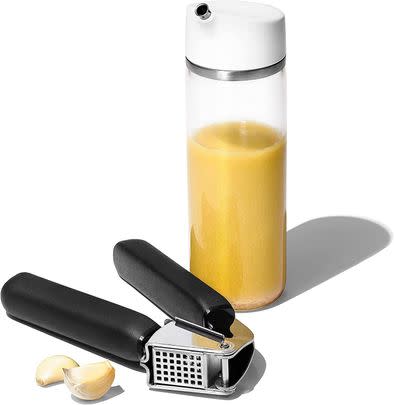
Amazon
OXO Good Grips soft- handled garlic press
A sturdy garlic press is also within easy reach in Asbell’s tool drawer. “It’s helpful for adding garlic to any dish without having to mince, and you don’t get that garlic stickiness or smell on your fingers,” she said. “Garlic is a healthy antioxidant and immune booster, so anything that makes it easier to add it to your cooking is great.”
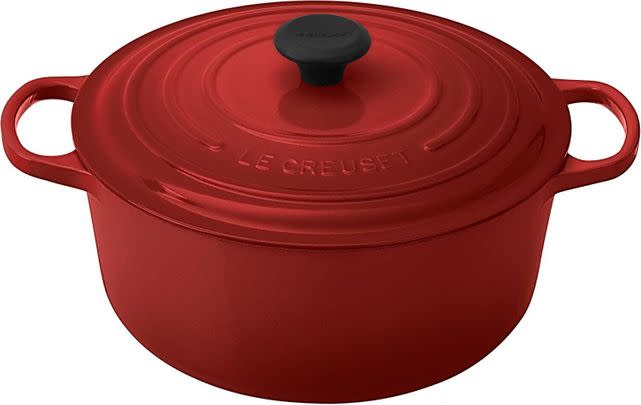
Amazon
Le Creuset enameled cast iron signature round Dutch oven
“My Le Creuset Cast Iron Dutch Oven is a kitchen workhorse that helps keep me healthy,” said food designer Shelagh Mullen. “I’ve had it for 27 years, and cleanup is still a breeze. Plus, just lifting it is a workout."
“I’ve used it to make countless healthy soups and stews — and some decadent ones, too," she continued. "It creates the perfect simmer for an all-day chicken stock. These pots hold in the heat, and you can cook acidic foods, like fresh tomato sauce, without worrying about corrosion.”
The Dutch oven isn’t just for liquids, Mullen explained: “It’s also what I use to bake the most gorgeous gut-healthy, sourdough bread. I toss an ice cube into the screaming-hot pot, slide the dough in with a parchment sling and pop on the lid. Exactly 50 minutes later, I have a golden, crusty loaf of bread.”
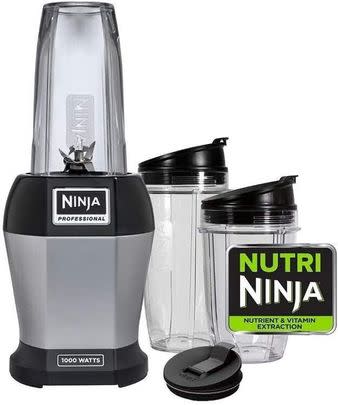
Amazon
Ninja BL455_30 Nutri Professional personal blender
A well-blended smoothie can be a good start to a healthy day, and our chefs have clear loyalties on the blenders they love best. “I’m obsessed with my Ninja BL455_30 Nutri Professional Personal Blender,” said Robin Selden, managing partner and executive chef of Marcia Selden Catering. “I begin my day with a protein smoothie, and this blender makes it so easy to do. I blend it in the 24-ounce cup, throw the pop-top on, and I’m on my way out the door.”
But while she praised its smoothie-making prowess, Selden said this blender does much more. “It’s awesome for blending soups, and I especially love it for gazpacho," she said. "I also use it for quick vinaigrettes and salad dressings. And, not going to lie, but there may have been some delicious skinny frozen margaritas I’ve made in my Ninja, too. The blades are so strong that they really crush through ice to make the best frozen cocktails ever.”

Amazon
Vitamix Ascent Series smart blender
Other chefs praised the healthful options made possible with another blender brand: Vitamix. This brand is genius at making pureed veggie soups that help with eating more veggies, said Anna Klimmek, a chef, health coach and owner of Happy Food MN, a culinary wellness company. “Having those soups on hand helps curb cravings for savory comfort that I often get during cold winter evenings,” she said. “I also use it to make homemade nut milks and nondairy cheeses like cashew ricotta.”
But is a Vitamix worth the price? Chef Marshall O’Brien gives an unequivocal “yes.” “I tried other blenders, but I used them a lot, and they would always die out,” he said. “The Vitamix is very durable. I’ve had mine for more than 10 years and it’s still going strong.”
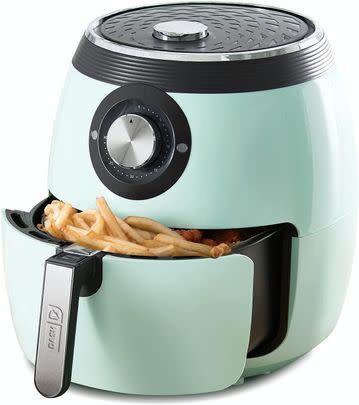
Amazon
Dash deluxe electric air fryer
When you crave a comforting crunch without the grease, an air fryer can be a handy kitchen helper. Selden swears by her Dash Deluxe electric air fryer. “I get crispiness with little to no fat, and all in just a matter of minutes,” she said. “I can throw an entire head of cauliflower or broccoli, or a whole bag of mini sweet colorful peppers, in it for a few minutes, and everything emerges with a delicious texture.”
One of her favorite air fryer appetizers starts with a can of chickpeas. “You end up with these crunchy little protein-packed bites that you can season with specialty salts or Tajin seasoning,” she said. Her children especially love her air fryer Buffalo cauliflower. “I lightly spray florets with oil, and once they’re crispy and golden brown, I toss them with Frank’s Red Hot Sauce,” she said.
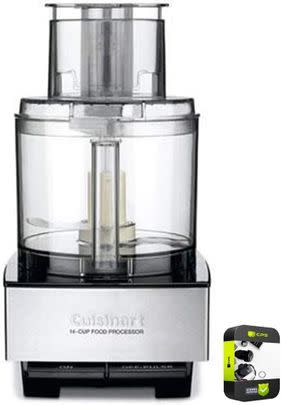
Amazon
Cuisinart food processors (14 cup and 7 cup)
Speeding up prep time is a great incentive for cooking better at home. For Chef Rossi, owner and executive chef of New York caterer The Raging Skillet, a set of small and large Cuisinart food processors are the “secret ingredients” for many healthful meals. “In my early chef days, I remember killing myself chopping, smashing and mixing up the ingredients for a simple pesto,” she recalled. “A co-worker noticed and said, ‘Sweetheart, if you like suffering, there’s a lovely S&M bar down the street. If not, buy a food processor. Life is short.’"
“From the moment I brought my first Cuisinart to the kitchen, I was reborn, and there was no more mincing and moaning,” Rossi said. “I could make four quarts of pesto in less than 10 minutes. Hummus came together like magic. My vinaigrettes emulsified in seconds."
“Now, I can’t imagine my life as a caterer without my large Cuisinart, which I call my esposa, or wife, and my small one, nicknamed my esposo, or husband. Not only do they make my life easier, but I now find I can often actually leave work before sunset. Even in the middle of high wedding season, I can take a long walk by the river, breathe deeply and smell the flowers. Folks ask me what I do to stay trim and healthy. I tell them that my esposa does most of the work, so I have time to exercise and channel my inner child.”


